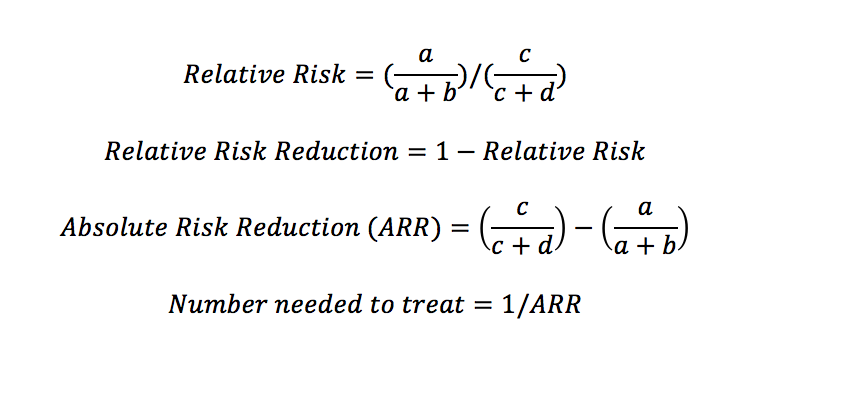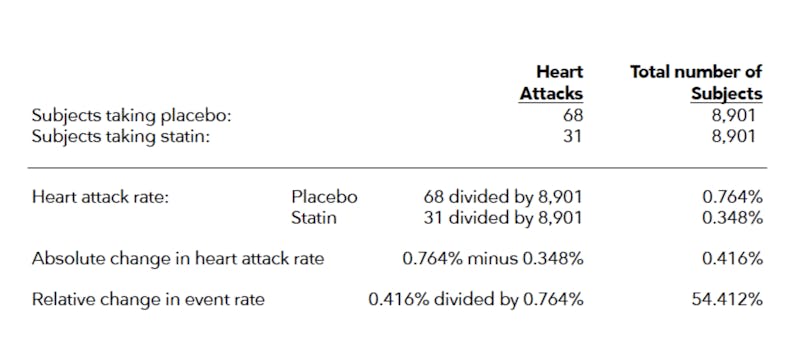An ANC of 05 x 10 3 uL was associated with a relative odds ratio of 48. In terms of measuring how a.
Eufic European Food Information Council Relative Risks Are Often Reported In Newspaper Headlines But Without The Context Of Absolute Or Baseline Risk This Information Is Meaningless Reporting Relative Risks Can
Relative Risk

Learning About Evidence Based Healthcare By Reading Journal Articles Cholesterol Drugs And Risk Students 4 Best Evidence
If something you do triples your risk then your relative risk increases 300.

Absolute relative risk. Disease A occurs in 1 in 100000 people. Even a mere 21 absolute risk reduction is a huge 300 improvement over. This infographic will help you to understand the difference between absolute risks and relative risks using the example of processed meat consumption and risk of bowel cancer.
Reporting absolute risk reduction measures is essential to prevent outcome reporting bias in evaluation of COVID-19 vaccine efficacy. The size of your absolute risk reduction depends on what your risk is to. Difference Between Absolute and Relative Path Hyperlinks commonly referred to as links are still one of the most important aspects and fundamental element of the World Wide Web.
The diagnostic value of absolute neutrophil count band count and morphologic changes of neutrophils in predicting bacterial infections. Absolute risk reduction is the number of percentage points your own risk goes down if you do something protective such as stop drinking alcohol. In the world of press releases Relative Risk is the younger more attractive cousin of Absolute Risk.
Absolute and relative are concepts that are used in life to know more about people things and ideasFor example if there is only one internet service provider in an area the customers not knowing the features and services of other ISP in other areas remain content with what they are. My understanding of the formulas leads to different result than they say. Relative risk is commonly used to present the results of randomized controlled trials.
Absolute risk numbers are needed to understand the implications of relative risks and how specific factors or behaviours affect your likelihood of developing a disease or health condition. Unreported absolute risk reduction measures of 07 and 11 for the PfzierBioNTech and Moderna vaccines respectively are very much lower than the reported relative risk reduction measures. Al-Gwaiz LA Babay HH.
The differences between absolute and relative gains in IR theory indicate the major differences between neoliberalism and neorealism. To make sense out of a relative risk one needs to know the absolute risk that is simply the likelihood that an outcome will occur. The difference between absolute and relative stems from the choice of comparison.
The corresponding absolute risk reduction for the PfizerBioNTech COVID-19 booster vaccine works out to approximately 21 with a 95 confidence interval of 17 25. The are saying that. So risk can be presented both in relative and in absolute terms using either the relative risk or the absolute risk.
However these concepts are critical for communicating information to your patients. Its the ability to create a link on a page that makes readers to directly follow or access other content within a document. Like for absolute risk aversion the corresponding terms constant relative risk aversion CRRA and decreasingincreasing relative risk aversion DRRAIRRA are used.
In a nutshell relative humidity is the ratio of moisture content in the air relative to the highest amount of moisture at a given temperature and is expressed in percentage. Though in agreement with the anarchic context of international relations neoliberals move away from the realists state-centric framework and advocate a mixed-actor model that includes international organizations NGOs multinational corporations and. Absolute risk reduction is the gold standard for approving vaccines for safe public use.
The Relative Risk Reduction RRR and the Absolute Risk Reduction ARR are two measurements that are calculated differently. Understanding absolute and relative risk reduction The differences between relative and absolute risk reductions are often poorly understood by health professionals and even more poorly understood by patients. If Absolute Risk is the Jan Brady of the research world Relative Risk is its Marcia.
But thats not the standard that is being used when you are being told that COVID-19 vaccines are 95 effective. Thus to calculate the relative risk we must know the exposure status of all individuals either exposed or not. This measure has the advantage that it is still a valid measure of risk aversion even if the utility function changes from risk averse to risk loving as c varies ie.
In this state of poverty even if the country is growing economically it has no effect on people living below the poverty line. Absolute poverty is when household income is below a certain level which makes it impossible for the person or family to meet basic needs of life including food shelter safe drinking water education healthcare etc. However the risk will be repeated until the individuals change their other behaviors get vaccinated or the pandemic essentially ceases.
If the absolute risk of developing the disease was 4 in 100 then this 25 reduction in relative risk would reduce the absolute risk to 3 in 100. The relative risk is confused by some with the odds ratio and absolute risk. Relative risk is the ratio of the probability of an event occurring with an exposure versus the probability of the event occurring without the exposure.
Luckily your literature evaluation skills dont have to be hampered by a lack of reporting. Absolute vs Relative. Absolute definition free from imperfection.
In the previous example the relative risk reduction of fever and rash in the group of the children on the. Its one of the most defining traits of websites especially. Absolute risk is the size of your own risk.
What is relative vs. Taking drug x reduces occurence to 1 in 10000000. Data and results given.
If 100 people do not take the medicine then 4 in those 100 people will get the disease. The relative risk RR of an event is the likelihood of its occurrence after exposure to a risk variable as compared with the likelihood of its occurrence in a control or reference group. Summary of Absolute vs.
However this can be looked at another way. Utility is not strictly convexconcave over all c. That is a relative risk reduction of 20 but an absolute risk reduction of only 05.
Relative return on the other hand is the difference between the absolute return and the performance of the market or other similar investments which is. Understanding the difference between absolute and relative risk reduction and why it matters. Relative risk reduction RRR tells you by how much the treatment reduced the risk of bad outcomes relative to the control group who did not have the treatment.
In this guide they try to teach how to calculate relative and absolute risk reduction. The RR is estimated as the absolute risk with the risk variable divided by the absolute risk in the control group. This can be problematic if the relative risk is presented without the absolute.

Reporting The Findings Absolute Vs Relative Risk

Relative And Absolute Risk Osmosis

Reporting The Findings Absolute Vs Relative Risk

Understanding Risk Coriell Personalized Medicine Collaborative

Opposing Age Related Trends In Absolute And Relative Risk Of Adverse Health Outcomes Associated With Out Of Office Blood Pressure Hypertension

Understanding Absolute And Relative Risk Diet Doctor

Risk Savvy Book Summary Gerd Gigerenzer Wise Words

Biostatistics Part 3 Relative Risk Risk Ratio Relative Risk Reduction Absolute Risk Reduction Youtube
- Ayat Lazim Rumi
- Daun Pandan In English
- Pelakon Komedi Perak Ganja Forum Cari
- Better Call Saul
- Resort Atas Laut Di Malaysia
- Seberang Jaya Flood
- Degrees I Can Get Online
- Event Management Recruitment
- What Is Akaun 55
- Anggota Band Seventeen
- Cara Cara Mengatasi Penyalahgunaan Dadah Dalam Kalangan Murid
- Pantun Terima Kasih Persembahan
- Pejabat Pentadbiran Hep Unisel
- Convert Pdf To Jpg Android Online
- Gambar Jangan Duduk Di Atas Bantal
- Pembangunan Manusia Menurut Islam
- Cx 5 Vs Kia Sorento
- Flight Dispatcher Jobs Salary
- Kerap Sakit Pinggang
- Laoran Latihan Industri Pentadbiran Sistem Komputer

